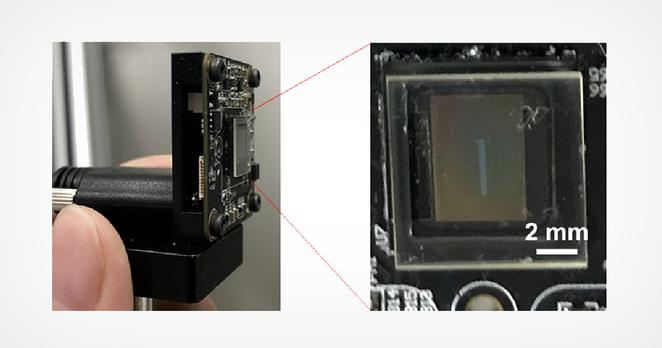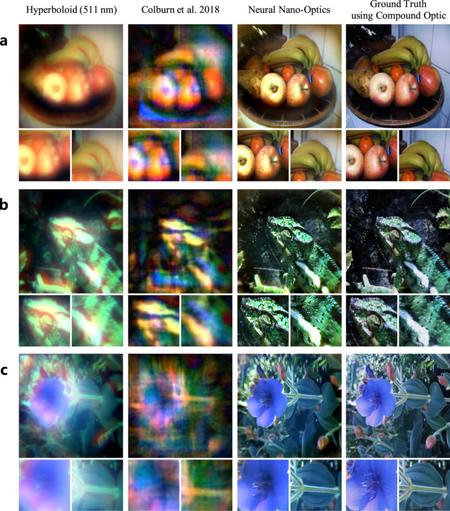Scientists Create Tiny Insect-Inspired Camera That Captures 9,120 FPS in Near Darkness https://petapixel.com/2025/05/13/scientists-create-tiny-insect-inspired-camera-that-captures-9120-fps-in-near-darkness/ #Technology #tinycamera #insecteye #9120fps #insects #News
#tinycamera
A Pigeon Took These Photographs https://petapixel.com/2024/04/14/a-pigeon-took-these-photographs/ #animalphotographer #insta360go3 #tinycamera #Spotlight #Features #pigeons
Researchers Shrink High-Res Camera Down to the Size of a Grain of Salt
Researchers from the University of Princeton and the University of Washington have developed a high-resolution, full-color camera that is the size of a grain of salt that is the next generation of metasurface technology.
Tiny cameras have long been thought to have the potential to see problems in the human body and help scientists and medical professionals treat various illnesses, but past implementations of metasurface-based compact cameras have only been able to produce fuzzy, distorted images with limited fields of view.
"While sensors with submicron pixels do exist, further miniaturization has been prohibited by the fundamental limitations of conventional optics," the researchers say. "Traditional imaging systems consist of a cascade of refractive elements that correct for aberrations, and these bulky lenses impose a lower limit on camera footprint. A further fundamental barrier is a difficulty of reducing focal length, as this induces greater chromatic aberrations."
But these researchers appear to have overcome these issues. In a paper published on Nature and summarized by Princeton University, the team shows that it was able to produce what they describe as "crisp" full-color photos that are "on-par" with a conventional compound camera that is 500,000 times larger. The team is calling the new camera a "neural nano-optic" system.
The metasurface is studded with 1.6 million cylindrical posts that are each roughly the size of an HIV virus. Each post has unique geometry and functions like an optical antenna, Princeton explains. These unique cylinders combine with machine learning algorithms that interpret how light hits each and combine the data together to produce high-quality images.
Below is a figure from the paper that shows what the neural nano-optic camera can capture compared to previous methods.
"We perform comparisons against a traditional hyperbolic meta-optic designed for 511 nm and the state-of-the-art cubic meta-optic from Colburn et al," the researchers explain. "Additional experimental comparisons against alternative single-optic and meta-optic designs are shown in Supplementary Note 11. Ground truth images are acquired using a six-element compound optic that is 550,000× larger in volume than the meta-optics. Our full computational reconstruction pipeline runs at real-time rates and requires only 58 ms to process a 720 px × 720 px RGB capture."
Previous micro-sized image example (left) versus the new neural nano-optics camera result (right). | Via Princeton Engineering
The researchers are now working to add more computational abilities to the camera, and beyond improving the image quality they would like to add the capability for object detection and sensing that would be relevant in medicine and robotics.
"We could turn individual surfaces into cameras that have ultra-high resolution, so you wouldn't need three cameras on the back of your phone anymore, but the whole back of your phone would become one giant camera," Felix Heide, the study's senior author and an assistant professor of computer science at Princeton says. "We can think of completely different ways to build devices in the future."
_Image credits: Header image from the research team, via Princeton University _
#equipment #news #technology #compactcamera #machinelearning #metalens #metaoptics #metasurface #metasurfaces #nanooptic #nanotechnology #neuralnanooptic #submicron #tinycamera
Vivo Designs Detachable Smartphone Camera with Tiny Touch Display
Vivo has designed a smartphone camera that detaches from the main body of the phone and takes a piece of the display with it, a curious design decision that allows the main cameras to be used for selfies… and more.
This new design appears to be an advancement on one that the company showed off in October of last year. That design concept went on to win a Red Dot Award, but it never became a consumer purchasable product. It appears Vivo didn't just rest on its laurels, however, and iterated on the design further.
Having the camera pop out of the phone and also be entirely removable would make it possible to allow the device to interchange with other camera modules. By separating the camera from the phone, the idea is that the design would enhance user-friendly shooting features that are normally constrained within the design of a mobile device.
This latest iteration ditches the pop-up feature and instead integrates the camera module with a piece of the display. According to the patent -- which was found and illustrated by LetsGoDigital -- this design would allow the camera to be used in three different ways.
The first mode would allow the module to be positioned so the secondary display -- which is about the size of an iPhone front-facing notch -- faces the front. The pixel density of this secondary display is identical to that of the smartphone's main display, so it blends into the main screen as if it was one seamless display.
The second mode involves flipping the module around 180-degrees so that the cameras face the user. The main benefit of this orientation is that it allows the use of the main cameras as selfie cameras.
Finally, the third mode involves removing the camera and display piece from the body of the smartphone entirely for remote operation. In this mode, the module can be used separately from the smartphone and the tiny display can be used to take pictures remotely. That small screen piece can be used to operate the camera and also see previews of photos or videos that are captured with it. Theoretically, it should also be possible to control the unit remotely with the main body of the smartphone to take wide-angle selfies with groups that would otherwise not be possible from a hand-held orientation -- for example, a user could set the module down on a bench or other surface and take a remote photo of themselves.
While detachable or interchangeable camera modules regularly come up in designs and patents, it hasn't been seen in a consumer product yet. While neat on paper, these ideas do have a complication in real-world use: small, interchangeable parts are very easily lost and are likely expensive to replace. While it is unlikely that Vivo will release such a concept in a finished product, it's still worth noting that the company is investigating new ways to integrate cameras into smartphones.
#mobile #news #design #detachable #detachablecamera #newtech #patent #smartphone #smartphonecamera #smartphonephotography #tinycamera #vivo



